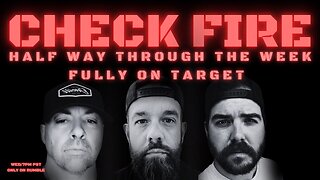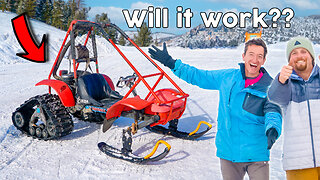Premium Only Content

Next-level thermal night vision fusion on deer
Essex foxshooter Robert Bucknell and his deerstalking buddy Nigel Fulton make their judgement about the new thermal / night vision fusion available from HIKMicro, plus Nigel takes it out to try for a fallow buck.
For more from HIKMicro about the Falcon FQ50 Pro monocular, and the binocular Raptor Pro RQ50L with a built-in rangefinder, go to https://www.hikmicrotech.com/en/outdoor/
▶ For the kit showcased in this film, visit https://kitfinder.co.uk
▶ Sign up for our weekly email newsletter https://FieldsportsChannel.tv/register
▶ To watch all of #FieldsportsBritain, episode 723, visit https://FieldsportsChannel.tv/fieldsportsbritain723
▶ Fieldsports Shop http://fieldsports.shop
▶ Take part in nature. Join the Fieldsports Nation https://FieldsportsChannel.tv/membership
Why shoot deer?
There are more than two million red, roe, fallow, sika, muntjac and Chinese water deer in Britain’s countryside and semi-urban areas, the highest level for 1,000 years. Numbers have doubled since 1999, according to the Deer Initiative, the UK government’s deer agency.
Deer are an attractive and an important part of our wildlife. However, they have no natural predator in the UK so numbers must be sensibly and strategically managed to keep them in balance with their habitat and to prevent damage to crops, trees, woodland flora, gardens and other wildlife.
Deer cause £4.5 million-worth (Forestry Commission Scotland) of damage to plantations and other commercial woodlands in Scotland. Crop damage is estimated at £4.3m a year according to DEFRA, with the greatest damage on cereal crops in east and south-west England.
More than 8,000 hectares (Parliamentary Office for Science and Technology) of woodland with SSI status is currently in ‘unfavourable’ or ‘recovering’ condition due to deer impacts such as browsing and fraying. Deer can also influence the variety of wildlife in woodlands and other habitats by altering structural and plant species diversity. According to the University of East Anglia’s Dr Paul Dolman, that has resulted in a 50% decline in woodland bird numbers where deer are present, impacting particularly on nightingales, blackcaps, chiffchaffs and warblers.
Deer are susceptible to Bovine TB and may be responsible for the transmission of TB to cattle. They are also the likely driver behind the UK’s increasing tick population (Scharlemann et al 2008).
Happily, venison is a delicious meat. It is wild, natural and free range, and – almost fat-free – it is one of the healthiest meats available today. Results from research commissioned by the Game-to-Eat campaign (Leatherhead Food International Research 2006) suggest that there are real health benefits to eating game. Venison is high in protein, low in saturated fatty acids and contains higher levels of iron than any other red meat.
We’re proud to promote enjoyment of fieldsports and the countryside. There are three guiding principles to everything we do on Fieldsports Channel:
▶ Shoot responsibly
▶ Respect the quarry
▶ Ensure a humane, clean and quick kill
-
 7:03
7:03
Fieldsports Britain
1 year agoBrimpsfield Park Estate game shoot
34 -
 2:55:11
2:55:11
TimcastIRL
12 hours agoDemocrat TANTRUM At Trump Speech BACKFIRES, Trump Polls UP, Dems UNDER FIRE w/67Kevin | Timcast IRL
223K110 -
 1:25:23
1:25:23
Kim Iversen
14 hours agoFrom Doctor to Political Prisoner: Dr. Simone Gold on COVID Lies, January 6th, and Medical Tyranny
128K79 -
 2:09:28
2:09:28
Melonie Mac
15 hours agoGo Boom Live Ep 39!
83K10 -
 1:04:36
1:04:36
Man in America
17 hours ago🚨 BREAKING: Dr. Robert Young JAILED! Medical Tyrants Will Do ANYTHING to Silence Truth
101K53 -
 3:01:44
3:01:44
I_Came_With_Fire_Podcast
15 hours agoPanama CANAL BlackROCKED | Left of PODCASTING | Ukraine AID GONE
55K8 -
 45:56
45:56
Glenn Greenwald
14 hours agoLee Fang Reacts to Trump's Speech to Congress; Will DOGE Tackle Military Waste? | SYSTEM UPDATE #418
140K104 -
 43:23
43:23
Donald Trump Jr.
15 hours agoNo Clap: Dems are a Disgrace but My Father is Bringing Back Common Sense | Triggered Ep.222
151K123 -
 18:29
18:29
The Rad Factory
1 day ago $3.24 earnedBuilding Shred Eighty a Custom Honda Snow Kart
69.4K8 -
 UPCOMING
UPCOMING
Precision Rifle Network
1 day agoS4E7 Guns & Grub - What makes group size increase?
31.9K2